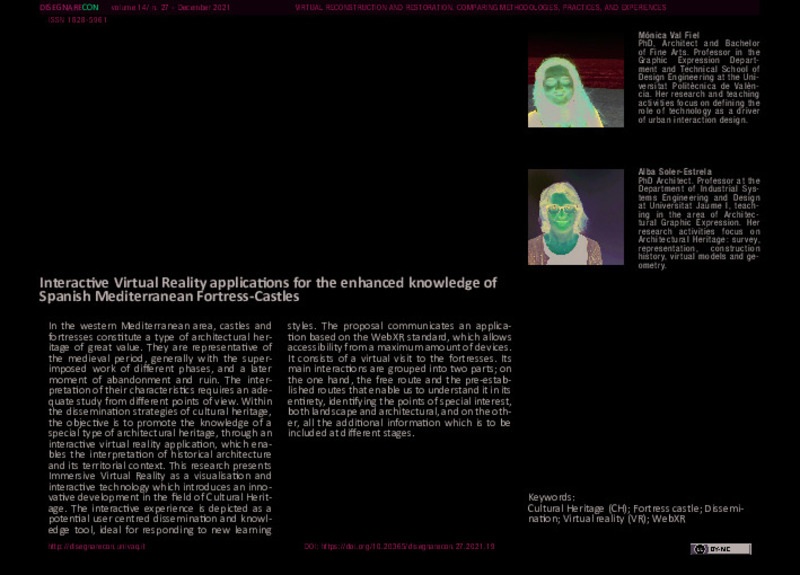JavaScript is disabled for your browser. Some features of this site may not work without it.
Buscar en RiuNet
Listar
Mi cuenta
Estadísticas
Ayuda RiuNet
Admin. UPV
Interactive Virtual Reality applications for the enhanced knowledge of Spanish Mediterranean Fortress-Castles
Mostrar el registro sencillo del ítem
Ficheros en el ítem
| dc.contributor.author | Val Fiel, Mónica
|
es_ES |
| dc.contributor.author | Soler-Estrela, Alba
|
es_ES |
| dc.date.accessioned | 2022-10-18T18:03:29Z | |
| dc.date.available | 2022-10-18T18:03:29Z | |
| dc.date.issued | 2021-12 | es_ES |
| dc.identifier.issn | 1828-5961 | es_ES |
| dc.identifier.uri | http://hdl.handle.net/10251/188191 | |
| dc.description.abstract | [ES] En la zona del Mediterráneo occidental, los castillos y fortalezas constituyen un tipo de patrimonio arquitectónico de gran valor. Son representativos de la etapa medieval, generalmente con la superposición de distintas fases, y un momento posterior de abandono y ruina. La interpretación de sus características requiere un estudio adecuado desde diferentes puntos de vista. Dentro de las estrategias de difusión del patrimonio cultural, el objetivo es promover el conocimiento de un tipo especial de patrimonio arquitectónico, a través de una aplicación interactiva de realidad virtual, que permita la interpretación de la arquitectura histórica y su contexto territorial. Esta investigación presenta la Realidad Virtual Inmersiva como una tecnología de visualización e interacción que introduce un desarrollo innovador en el campo del Patrimonio Cultural. La experiencia interactiva se presenta como una herramienta potencial de divulgacion y conocimiento centrado en el usuario, idónea para dar respuesta a los nuevos estilos de aprendizaje. La propuesta presenta una aplicación basada en el estándar WebXR, que permita la accesibilidad desde el mayor número de dispositivos. Consiste en una visita virtual a las fortalezas. Sus principales interacciones se agrupan en dos conjuntos, por un lado, el recorrido libre y las rutas preestablecidas que permitan comprender el conjunto, identificando los puntos de especial interés, tanto paisajístico como arquitectónico, y por otro, toda la información adicional que se quiere incluir a distintos niveles. | es_ES |
| dc.description.abstract | [EN] In the western Mediterranean area, castles and fortresses constitute a type of architectural heritage of great value. They are representative of the medieval period, generally with the superimposed work of different phases, and a later moment of abandonment and ruin. The interpretation of their characteristics requires an adequate study from different points of view. Within the dissemination strategies of cultural heritage, the objective is to promote the knowledge of a special type of architectural heritage, through an interactive virtual reality application, which enables the interpretation of historical architecture and its territorial context. This research presents Immersive Virtual Reality as a visualisation and interactive technology which introduces an innovative development in the field of Cultural Heritage. The interactive experience is depicted as a potential user centred dissemination and knowledge tool, ideal for responding to new learning styles. The proposal communicates an application based on the WebXR standard, which allows accessibility from a maximum amount of devices. It consists of a virtual visit to the fortresses. Its main interactions are grouped into two parts; on the one hand, the free route and the pre-established routes that enable us to understand it in its entirety, identifying the points of special interest, both landscape and architectural, and on the other, all the additional information which is to be included at different stages. | es_ES |
| dc.language | Español | es_ES |
| dc.language | Inglés | es_ES |
| dc.publisher | Università di Bologna | es_ES |
| dc.relation.ispartof | DisegnareCon | es_ES |
| dc.rights | Reconocimiento - No comercial (by-nc) | es_ES |
| dc.subject | Cultural Heritage (CH) | es_ES |
| dc.subject | Fortress castle | es_ES |
| dc.subject | Dissemination | es_ES |
| dc.subject | Virtual reality (VR) | es_ES |
| dc.subject | WebXR | es_ES |
| dc.subject.classification | EXPRESION GRAFICA ARQUITECTONICA | es_ES |
| dc.title | Interactive Virtual Reality applications for the enhanced knowledge of Spanish Mediterranean Fortress-Castles | es_ES |
| dc.type | Artículo | es_ES |
| dc.identifier.doi | 10.20365/disegnarecon.27.2021.19 | es_ES |
| dc.rights.accessRights | Abierto | es_ES |
| dc.contributor.affiliation | Universitat Politècnica de València. Departamento de Expresión Gráfica Arquitectónica - Departament d'Expressió Gràfica Arquitectònica | es_ES |
| dc.description.bibliographicCitation | Val Fiel, M.; Soler-Estrela, A. (2021). Interactive Virtual Reality applications for the enhanced knowledge of Spanish Mediterranean Fortress-Castles. DisegnareCon. 14(27):1-15. https://doi.org/10.20365/disegnarecon.27.2021.19 | es_ES |
| dc.description.accrualMethod | S | es_ES |
| dc.relation.publisherversion | https://doi.org/10.20365/disegnarecon.27.2021.19 | es_ES |
| dc.description.upvformatpinicio | 1 | es_ES |
| dc.description.upvformatpfin | 15 | es_ES |
| dc.type.version | info:eu-repo/semantics/publishedVersion | es_ES |
| dc.description.volume | 14 | es_ES |
| dc.description.issue | 27 | es_ES |
| dc.relation.pasarela | S\461023 | es_ES |
| dc.subject.ods | 04.- Garantizar una educación de calidad inclusiva y equitativa, y promover las oportunidades de aprendizaje permanente para todos | es_ES |
| dc.subject.ods | 11.- Conseguir que las ciudades y los asentamientos humanos sean inclusivos, seguros, resilientes y sostenibles | es_ES |








